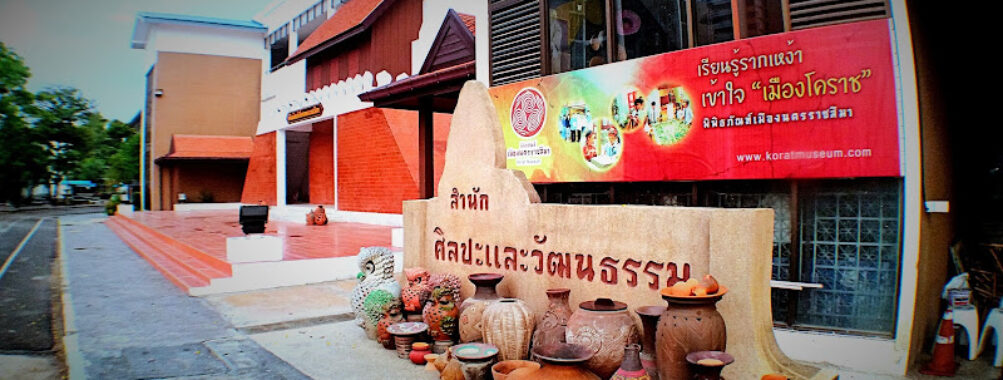
Korat Museum
Table of Contents
Description
The Korat Museum is one of those places that quietly surprises travelers who take the time to step inside. Located on the second floor of a cultural building, it’s not flashy or overwhelming, but that’s part of its charm. Instead of being bombarded with endless exhibits, visitors find a thoughtful collection of displays and artifacts that speak directly to the history and traditions of the Korat region. It feels approachable, almost like a conversation with the past rather than a lecture. You don’t need to be a historian to appreciate it—just a little curiosity will do.
The museum showcases relics, tools, and educational displays that paint a picture of what life in the region used to be like. From everyday household items to more ceremonial pieces, each artifact tells a story. And while some museums can feel overwhelming with too much information crammed into every corner, here it’s more balanced. The space itself is easy to navigate, which makes it especially good for families with children or anyone who prefers a slower, more reflective pace.
It’s worth noting that the museum isn’t trying to be a grand, world-class institution. It’s modest in scale, but that’s exactly why people often leave with a genuine sense of connection to the region. You’ll find a mix of reactions—some people are deeply impressed by the cultural depth, while others might find it a bit simple compared to bigger museums in Bangkok or Chiang Mai. Personally, I think that’s part of the appeal. It’s not about dazzling displays but about grounding yourself in the local story of Korat.
Accessibility is another plus. The museum provides wheelchair-accessible restrooms and has a straightforward layout that makes it easy to move around. Families with children will also appreciate that it’s not too large, so kids don’t get worn out halfway through. And yes, there are restrooms available, which may seem like a small detail, but when you’re traveling, these little conveniences matter more than you’d think.
Key Features
- Second-floor museum dedicated to the history and heritage of the Korat region
- Educational displays that are clear and easy to understand
- Artifacts ranging from household items to ceremonial objects
- Wheelchair-accessible restrooms for greater convenience
- Family-friendly environment, good for kids and easy to navigate
- Balanced size—large enough to be interesting but not overwhelming
- Atmosphere that feels personal and grounded in local culture
Best Time to Visit
Timing really can shape your experience here. The museum is indoors, so weather isn’t a huge factor, but visiting during the cooler months (roughly November to February) makes the whole trip to Korat more pleasant overall. If you’re already exploring the city during the hot season, the museum is actually a nice escape from the heat. It’s not typically crowded, so you don’t have to worry too much about peak hours. Mid-morning or early afternoon is often ideal—you’ll have enough time to wander without feeling rushed, and you can pair the visit with a meal at a nearby restaurant.
Personally, I recommend avoiding late afternoons, only because your energy might dip by then, and the museum deserves at least a little focus. It’s not a place you need hours and hours for, but giving yourself at least 60–90 minutes will allow you to take it all in without hurrying.
How to Get There
Reaching the Korat Museum is relatively straightforward once you’re in the city. Public transportation options like songthaews (shared pickup trucks) and tuk-tuks are common and affordable, though they may not drop you right at the door. If you’re not familiar with local routes, a taxi or a ride-hailing app is usually the easiest option. Driving yourself is also possible if you’ve rented a car, and parking is generally available nearby.
For those who enjoy walking, the museum is within a reasonable distance of other city attractions, so it can be part of a day spent exploring the central area. Just keep in mind that Korat can get hot, so bring water if you’re on foot.
Tips for Visiting
Here’s where a little insider advice can make your visit smoother. First, don’t rush. Even though the museum isn’t huge, it deserves your attention. Take the time to read the displays—they’re straightforward and informative, and you’ll walk away with a much richer sense of the region.
If you’re traveling with kids, this is a good spot to introduce them to history without overwhelming them. The size of the museum works in your favor here. And since there are restrooms available, you don’t have to stress about logistics.
Another tip: bring a light sweater or scarf. Some indoor spaces in Thailand crank up the air conditioning more than you’d expect, and it can feel chilly after a while. Also, photography rules can vary, so check before snapping pictures of the exhibits.
From my own experience, I’d suggest combining the museum visit with other cultural stops in the city. It’s not the kind of place you’d spend an entire day at, but it adds depth to a broader itinerary. Plus, it gives you a nice break from the hustle of markets or temples.
Lastly, keep your expectations in check. This isn’t the Louvre, and it’s not trying to be. It’s a local history museum with a personal touch, and if you approach it with that mindset, you’re more likely to enjoy it. Think of it as a way to connect with the soul of Korat rather than a blockbuster attraction.
Location
Places to Stay Near Korat Museum
Find and Book a Tour
Explore More Travel Guides
No reviews found! Be the first to review!